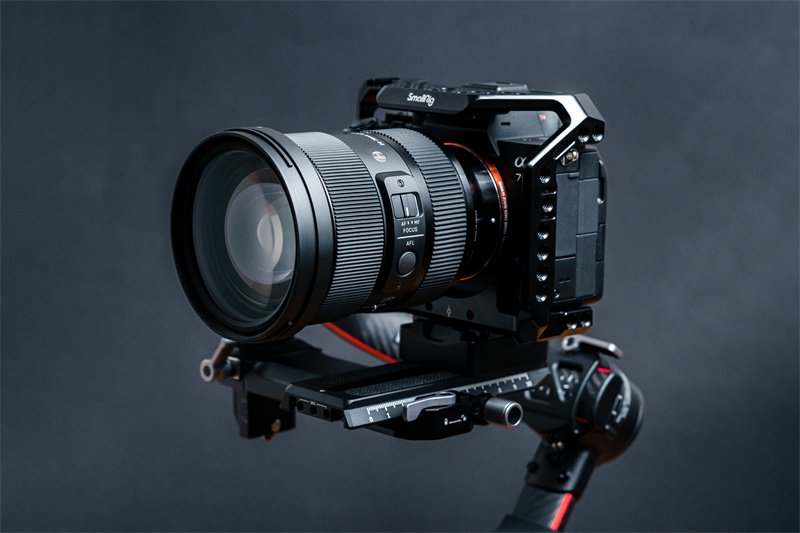The Best Videography Equipment Guide for Beginners

Are you planning to start your videography career or just want to pursue it as a hobby? Video marketing has become a growing trend, and the demand for videographers has also increased. Almost every brand is leveraging the power of videos to leave a strong impression on their prospects.
If you want to opt for this as a passion or a career choice, the most important thing will be to choose the right video equipment like a camera, accessories, etc.
These can bring all the difference to the video output including its quality. So here we are with a comprehensive guide to help you make an informed choice. This guide covers everything you need to know about the best videography equipment.
Part 1: What to Consider Before Buying Videography Equipment
Before buying any video production equipment, you have to consider certain things that are essential for making the right choices:
Budget
No matter what you want, it can't be purchased unless and until you have the required budget. Thus, find the video equipment that fits under your budget. Sit down for a while with your thoughts, pen and paper. Take note of all the necessary video equipment and then check whether they come under your budget. This will help in identifying where to compromise.
Team Size
Are you working alone or with a team? If you are alone then affording everything is not possible. You will have to make certain compromises. However, working with a team by your side will increase the purchasing power and you can acquire more to work together.
Purpose
Whether you are opting for a long-term career option or a short-term opportunity to live it as a hobby, this also helps you determine the kind of equipment you need. For instance, if you are buying it to capture family and friends videos, there's no need for lightning or any other special equipment.
Part 2: Video Production Equipment and Gear Essentials
After considering the above things, it's time to take a look over the video production equipment and required gear essentials.
Main Camera and Lenses
Here we have listed the top 6 best Sony videography cameras for video production.
Lenses permit you to adjust the focus according to the video you want to film. There are two choices to make including prime lens and zoom lens. A prime lens comes with a non-adjustable focal length and is best when capturing some stationary object.
On the other hand, a zoom lens comes with an adjustable focus. Choosing the latter would be best though because you get the freedom to capture moving objects in a crystal-clear manner.
Fujifilm Fujinon XF 33mm is one of the most demanded prime lenses by videographers. In case you need a zoom lens then choose Fujifilm Fujinon XF 50-140mm because it has an elegant design and three-dimensional effect to aid you in capturing the pictures and videos in your desired way.
Videography Camera: OBSBOT Tail 2
The Tail 2 is the ultimate choice for beginners venturing into videography, combining advanced technology with user-friendly features. Its AI Tracking 2.0 automatically follows subjects, ensuring they stay in focus without the need for complex adjustments. The world's first PTZR camera offers hands-free 90° rotation, making it easy to capture dynamic angles effortlessly. With impressive capabilities of 4K@60fps and 1080P@120fps, users can produce high-quality footage that stands out. The 5x optical zoom and 12x hybrid zoom provide creative flexibility for experimenting with compositions.
Audio Equipment
Don't underestimate the audio part. It's important to get a video that perfectly syncs the audio in your video. For this, you will have to buy a microphone and some audio cables.
- HDMI cables are good to go with the DSLR and HD camcorders.
- USB Cables are another option to connect your camera to your computer for editing videos.
- A balanced audio signal can be gained with the help of an XLR cable.
- If you are in the music industry and need to use musical instruments in video recording, a MIDI cable is important so you can attach musical instruments to your videos.
Lighting
Videography in outdoor settings is generally done during daylight but indoor setting demands a good source of light. No matter how robust a camera you have, lightning brings clarity and difference to the video output. It highlights the subject and covers the dark spots while filming interviews. Personally, we found the NiceVeedi Led Photography Lighting Kit as the ideal lightning kit option for beginners. Better options are there but this will be sufficient to meet your project needs.
Stabilization Gear
Capturing a stable video using your camera isn't an easy task. Your hand can shake and sudden movement can ruin the video output. This is why a stabilization gear is a must even when your camera contains a stabilization feature. It allows the filmmaking from multiple angles. Things that you should take into account when choosing a stabilization gear:
- Must be durable to be available for use for a long time.
- Should be flexible to enable video capturing from multiple angles.
- Check for its compatibility with your camera.
- Pick the stabilization gear that extends up to some great height.
Accessories
Accessories cover many items like headphones, mount rigs, gimbals, etc. These accessories enable you to do additional things like capturing a film, podcast, and selfie videos. Apart from them, editing software also falls under this category. Though a plethora of choices are available for headphones, and other accessories, the only recommended one for video editing is Adobe Premiere Pro.
Memory Cards: Types and Speeds
Memory cards come in different types and data transfer speeds. It's always good to get at least 32GB of memory card size when you have to capture multiple videos of long duration. This is because a 4K video of half an hour duration can occupy 5-10 GB of storage space. In addition to your primary memory card, carry an extra impact flash memory card as a backup storage space.
Batteries: Extended Battery Packs
When you are in an outdoor recording setting with no way out to charge your camera, don't forget to get an extended battery pack. On the minimum, a long-term shoot will need at least 3-4 batteries so advise you to have rechargeable ones that will work as a backup power source for your camera. Keep in mind to check with the manufacturer whether it's compatible with your camera or not.
Bags and Cases: Protective Gear for Equipment
So you have a camera and other equipment but how to take it from one place to another without damage? This can only be done by buying a protective gear to ease carrying them safely.
Just make sure to pick a weather-resistant and sturdy enough to last for a long time. Don't worry about the brand though, focus on the budget part so you can cover your emergency device care expenses.
Filters: ND Filters/Polarizers
Both ND filters and polarizers are kind of thin glass pieces that you can attach in front of your camera. They act as a protection to the front part of your lens and also modify the final image output.
If you are interested in capturing scenic views and outdoor photographs then it's a must to get video equipment. ND filters reduce the light hitting the camera lens, handle reflections, and maintain glare as required whereas Polarizers can block lights of specific waves.
Hoya Variable Density II and Hoya Fusion One Next Cir-PL are two of the best ND filters and polarizers available in the market today. If you are confused about what to get, buy any of them without any second thought.
Part 3: FAQs about Videography Equipment
1. What is the most important piece of videography equipment?
Without any second thought, it's the camera, and then comes the tripod, audio, lighting equipment, lenses, batteries, and so on. Each of them is significant to build and grow in your videography career.
2. How do I start building my videography equipment kit?
The secret to building your videography equipment kit starts with choosing the ideal camera that aligns with your current or future project needs. After that, the hunt for lenses, stabilization gear, audio, lighting, storage, and other accessories begins. But stay prepared with a list so you can have everything you need.
3. How often should I upgrade my videography gear?
Consider upgrading your videography gear when it starts limiting your creativity and represents wear or tear. Moreover, if it's not aligned with the current project needs or you are planning to move according to the evolving advancements then upgrading videography gear is a must.
Conclusion
Starting your videography career is an exciting and challenging journey initially. However, with the discovery of the right videography tools, it becomes easier to do and get better. If you have already decided to enter this field, don't hold yourself back.
Let your creativity and talent come to the world, and in this journey, OBSBOT Tail 2 can play a critical role. Combining it with other top-notch accessories can help you record professional-quality videos and leave a positive impression on others.

















